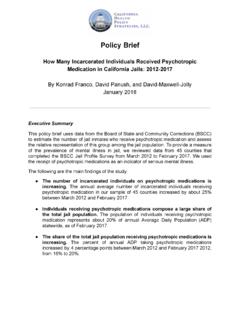Transcription of OECD reviews of vocational education and training …
1 OECD reviews of vocational education and training Learning for Jobs POINTERS FOR POLICY DEVELOPMENT Table of Contents Key policy challenges .. 5 The vocational challenge .. 7 Meeting labour market needs .. 9 Career guidance .. 11 Effective teachers and trainers .. 13 Workplace learning .. 15 Tools to support the VET system .. 17 Strengths, challenges and recommendations Australia .. 19 Austria .. 21 Belgium (Flanders) .. 23 Chile .. 25 China .. 27 Czech Republic .. 29 England and Wales .. 31 Germany .. 33 Hungary .. 35 Ireland .. 37 Korea .. 37 Mexico.
2 41 Norway .. 43 South Carolina .. 45 47 Switzerland .. 49 Texas .. 51 The OECD s policy review of vocational education and training (VET), Learning for Jobs, comprises a programme of analytical work and individual country reviews and is designed to help countries make their VET systems more responsive to labour market needs. Further information about the policy review and 17 country reviews of VET systems are available on the OECD website Directorate for education , education and training Policy Division May 2011 5 Key policy challenges P R O VIDE T H E R IGH T M IX O F S KILLS FO R T H E LABO UR M AR KE T For vocational programmes beyond secondary level, share the costs between government, employers and individual students according to the benefits obtained.
3 Provide a mix of VET training places that reflects both student preferences and employer needs. Achieve this through provision of workplace training and through planning and incentive mechanisms. Engage employers and unions in curriculum development and ensure that the skills taught correspond to those needed in the modern workplace. Through VET systems, provide young people with generic, transferable skills to support occupational mobility and lifelong learning, and with occupationally-specific skills that meet employers immediate needs. Ensure all students in vocational programmes have adequate numeracy and literacy skills to support lifelong learning and career development.
4 Identify and tackle weaknesses in this area. R E FO R M C AR E ER GUIDA NC E TO DE LIVE R E FFE C TIVE ADV IC E FO R ALL Develop a coherent career guidance profession, independent from psychological counselling and well-informed by labour market information. Provide adequate resources for career guidance and its pro-active delivery. Ensure an independent base to support objective career guidance. Provide good sources of information about careers and courses. Build a comprehensive framework of guidance through partnership with employers. Ensure that career guidance initiatives are properly evaluated.
5 E NS UR E T E ACH E RS AND T R AINE R S AR E W E LL-P RE P AR E D W IT H INDUS TRY E XP E R IE NC E Recruit sufficient teachers and trainers for VET institutions, and ensure this workforce is well-acquainted with the needs of modern industry. To this end: Encourage trainers in VET institutions to spend some of their time working in industry. Promote flexible pathways of recruitment and make it easier for those with industry skills to become part of the workforce of VET institutions through effective preparation. Provide appropriate pedagogical and other preparation for trainers (including supervisors) of interns, trainees and apprentices in workplaces, adapting the level of preparation to the nature of the workplace learning being provided.
6 Encourage interchange and partnership between VET institutions and industry, so that vocational teachers and trainers spend time in industry to update their knowledge, and vocational trainers in firms spend some time in VET institutions to enhance their pedagogical skills. Directorate for education , education and training Policy Division May 2011 6 M AKE FULL US E O F W ORKP LAC E LE AR NING Make substantial use of workplace training in initial VET. Ensure that the framework for workplace training encourages both employers and students to participate. Ensure workplace training is of good quality, through an effective quality assurance system and a clear contractual framework for apprenticeships.
7 Balance workplace training by other provision ( training workshops in schools) where other learning environments work better, or if workplace training is not available. Devise effective responses to the current economic downturn, to sustain workplace training , and cope with increased demand for full-time VET. DE VE LO P T OO LS TO E NGAGE S T AKE H O LDE RS AND P R O MO T E T R ANS P ARE NC Y Engage employers and unions in VET policy and provision through effective mechanisms. Systematically engage with employers, trade unions and other key stakeholders to develop and implement qualification frameworks, supported by strengthened quality assurance.
8 Adopt standardised national assessment frameworks to underpin quality and consistency in training provision. Strengthen data on labour market outcomes of VET, and provide the institutional capacity to analyse and disseminate that data. Directorate for education , education and training Policy Division May 2011 7 The vocational challenge W H Y LO O K AT VO C AT IONAL EDUC AT IO N AND T R AINING? Global economic competition increasingly requires countries to compete on the quality of goods and services. That requires a labour force with a range of mid-level trade, technical and professional skills alongside the high-level skills associated with university education .
9 Strains in existing vocational systems include lack of workplace training places and trainers. In some countries the rapid expansion of tertiary education has undermined school-based VET. VET has been neglected: it has received limited attention compared to other parts of the education system and is often seen as having lower status. W H Y IS INIT IAL VO C ATIO NAL E DUC AT IO N AND T R AINING NE E DE D? Employees learn many skills in the workplace either informally or through formal training . But for several reasons, vocational training cannot simply be left to employers. Firms provide firm-specific training to their employees, but they have little incentive to provide training for general skills.
10 Firms may also face barriers or be too small to provide effective training . Employers may be reluctant to recruit young people unless they are job ready , especially where hiring young inexperienced people is expensive ( because of employment rules) Those with lower levels of education , who would benefit the most from additional skills, are less likely to develop new skills once in the labour market. A high-skilled labour force may encourage investment in the country, increasing economic growth, while an employee s skills may promote the skills of workmates ( creating positive spillovers ). vocational programmes can pay off in the labour market, with studies showing good rates of return for upper secondary VET.















